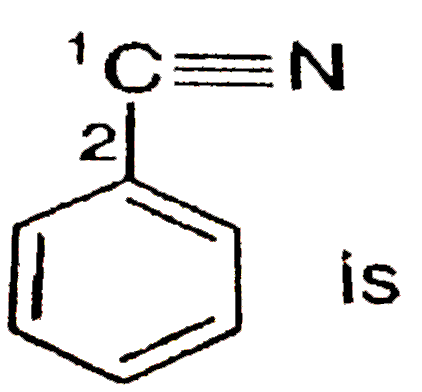Complete Solutions to Practise exercise of chapter GENERAL ORGANIC CHEMISTRY of Class 12 book with complete answers and questions
| Class 12 | CHEMISTRY |
| Chapter | GENERAL ORGANIC CHEMISTRY |
| BITSAT GUIDE | Practise exercise |
| Number Of Questions | 56 |
| Academic Year | 2023-24 |
Which of the following are aromatic compounds ?

View Solution`3^(@)` carbon is present in the compound
View Solutionchoose the compound in which all the carbon atoms have `66.7%` p-charater.
View SolutionThe bond between carbon atom (1) and carbon atom (2) in compound

View SolutionElectronegativity of carbon atoms depends upon their state of hybridisation in which of the following compounds the carbon marked asterisk, is most electronegative ?
View SolutionThe hybridisation of `C_(2)` carbon atom present in
`overset(3)CH_(2)=overset(2)C=overset(1)CH_(2)`
View SolutionThe kind of valency that exists in `CaH_(2)` and `C_(2)H_(2)` is
View Solution3 - methyloctance can be represented in which of the following forms ?
View SolutionWhich of the following is a heterocyclic alicyclic compound ?
View SolutionThe IUPAC name of the isomer of `CH_(3)-CH=NOH` would be
View SolutionPyruvic aldehyde is nothing but
View SolutionThe IUPAC name of the following compound is

View SolutionThe correct IUPAC name of

View SolutionThe IUPAC name of
 is
is
View SolutionThe IUPAC name of the compound shown below is

View SolutionWhat is the correct IUPAC name of the following compound ?

View SolutionThe correct IUPAC name of the given structures will be
I. `CH_(3)-overset(O)overset(||)(C )-CH_(2)-CH_(2)-CH_(2)-COOH`
II. CH-=C-CH=CH-CH=CH_(2)`
Choose the correct option.
View SolutionThe IUPAC name of

View SolutionThe IUPAC name of

View SolutionWhich skeleton exhibit optical isomerism?
View SolutionIn which isomer of `C_(7)H_(7)NO_(2)` there are two functional groups ?
View SolutionThe pair of functional group isomers is
View SolutionThe compound `C_(n)H_(2n)[n=4]` does not exhibit the which of the following isomerism?
View SolutionGeometrical isomerism is shown by
View SolutionThe compound 2,3- dichlorobutane exhibits
View SolutionThe number of constitutional isomers of the formula `C_(5)H_(11)` Br is
View SolutionHow many optical isomers are possible on monochlorination of 2-methyl butane?
View SolutionThe structural formula of 2-oxo-3-methyl-(N-bromo) butanamide is
View SolutionMatch the items of column I with the column II and choose the correct option from the codes given below.

View SolutionExample of geometrical isomerism is
View SolutionAmong the following four structures I to IV
I `{:(" "CH_(3)),(" "|),(C_(2)H_(5)-CH-C_(3)H_(7)):}`
II `{:(" "O" "CH_(3)),(" || |"),(CH_(3)-C-CH-C_(2)H_(5)):}`
III `H-undersetHunderset|oversetHoverset|(C^(oplus))`
IV `overset(CH_(3))overset(|)underset(C_(2)H_(5)-CH-C_(2)H_(5)` it is true that
View SolutionThe correct statement about the compounds A, B and C is

View SolutionIf `overset(CH_(3)-CH-CHO)overset(|)underset(CH_(3)` Carbanion would be
View SolutionIn which case, lonic mechanism is not followed ?
View SolutionWhich compound is more sensitive to undergo `S_(N)` 1 reaction?
View SolutionThe enolic form of acetone contains:
View SolutionConsider the following carbocations
I `overset(+)underset((CH_(3))_(3)C CH_(2)`
II `(CH_(3))_(3)C^(+)`
III `{:(" " +),(CH_(3)CH_(2)CH_(2)):}`
IV `{:(" " +),(CH_(3)-CH-CH_(3)):}`
The correct order for the stability of the above carbocations is
View SolutionThe solvent in which enol form of ethylacetoacetate is maximum is
View SolutionWhich among the following compounds will give maximum enol content in solution?
View SolutionWhat is the correct order of decreasing stability of the following cations ?
`overset(oplus)underset(CH_(3)-CH-CH_(3)`
II `overset(oplus)underset(CH_(3)-CH-OCH_(3)`
III `overset(oplus)underset(CH_(3)-CH-CH_(2)-OCH_(3)`
View SolutionThe increasing order of stability of the following free radicals is:
View SolutionWhich one of the following species is not an electropile?
View SolutionThe correct decreasing order of priority for the functional groups of organic compounds in the IUPAC system of nomenclature is
View SolutionCorrect order of nucleophilicity is
View SolutionConsider the following transformations
I `CH_(3)^(-) rarr`
`CH_(3)^(-) X rarr`
III `CH_(3)^(-)X rarr`
Carbon species formed in I, II and III respectively are
View SolutionWhich is the most stable carbocation?
View SolutionSelect the correct statement about the following reaction

View SolutionConsider the following reactions:

View SolutionArrange the following in increasing order of acidic strength
I. `H_(2)SO_(4)`
II. `(CH_(3))_(3)CH(SH)`
III. `CH_(3)CH_(2)^(+)OH_(2)`
IV. `CH_(3)CH_(2)CH_(3)`
View SolutionChoose the correct order of stability of carbocation using concept of hyperconjugation
I `CH_(3)-overset(CH_(3))overset(|)underset(CH_(3))underset(|)(C^oplus)`
II. `CH_(3)-overset(CH_(3))overset(|)underset(H)underset(|)(C^(oplus))`
III. `CH_(3)overset(oplus)CH_(2)`
IV `overset(oplus)CH_(3)`
View SolutionChloroacetic acid is a stronger acid than acetic acid this can be explained using
View Solution`CH_(3)CH_(2)Cl` undergoes homolytic fission to produce
View SolutionWhich alkenol is stable ?
View SolutionWhich of the following is not a free radical ?
View SolutionAmong the following, the least stable resonance structure is :
View SolutionCarbocation stability
`overset+CH_(3)ltCH_(3)overset+CH_(2)lt(CH_(3))_(2)overset+CH lt (CH_(3))_(3)overset+C:`
Alkyl radical stability
View Solution
Practise exercise questions and complete solutions for chapter GENERAL ORGANIC CHEMISTRY of BITSAT GUIDE of Class 12